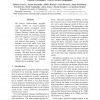Free Online Productivity Tools
i2Speak
i2Symbol
i2OCR
iTex2Img
iWeb2Print
iWeb2Shot
i2Type
iPdf2Split
iPdf2Merge
i2Bopomofo
i2Arabic
i2Style
i2Image
i2PDF
iLatex2Rtf
Sci2ools
NAACL
2007
2007
Analysis of Morph-Based Speech Recognition and the Modeling of Out-of-Vocabulary Words Across Languages
We analyze subword-based language models (LMs) in large-vocabulary continuous speech recognition across four “morphologically rich” languages: Finnish, Estonian, Turkish, and Egyptian Colloquial Arabic. By estimating n-gram LMs over sequences of morphs instead of words, better vocabulary coverage and reduced data sparsity is obtained. Standard word LMs suffer from high out-of-vocabulary (OOV) rates, whereas the morph LMs can recognize previously unseen word forms by concatenating morphs. We show that the morph LMs generally outperform the word LMs and that they perform fairly well on OOVs without compromising the accuracy obtained for in-vocabulary words.
| Added | 30 Oct 2010 |
| Updated | 30 Oct 2010 |
| Type | Conference |
| Year | 2007 |
| Where | NAACL |
| Authors | Mathias Creutz, Teemu Hirsimäki, Mikko Kurimo, Antti Puurula, Janne Pylkkönen, Vesa Siivola, Matti Varjokallio, Ebru Arisoy, Murat Saraclar, Andreas Stolcke |
Comments (0)

